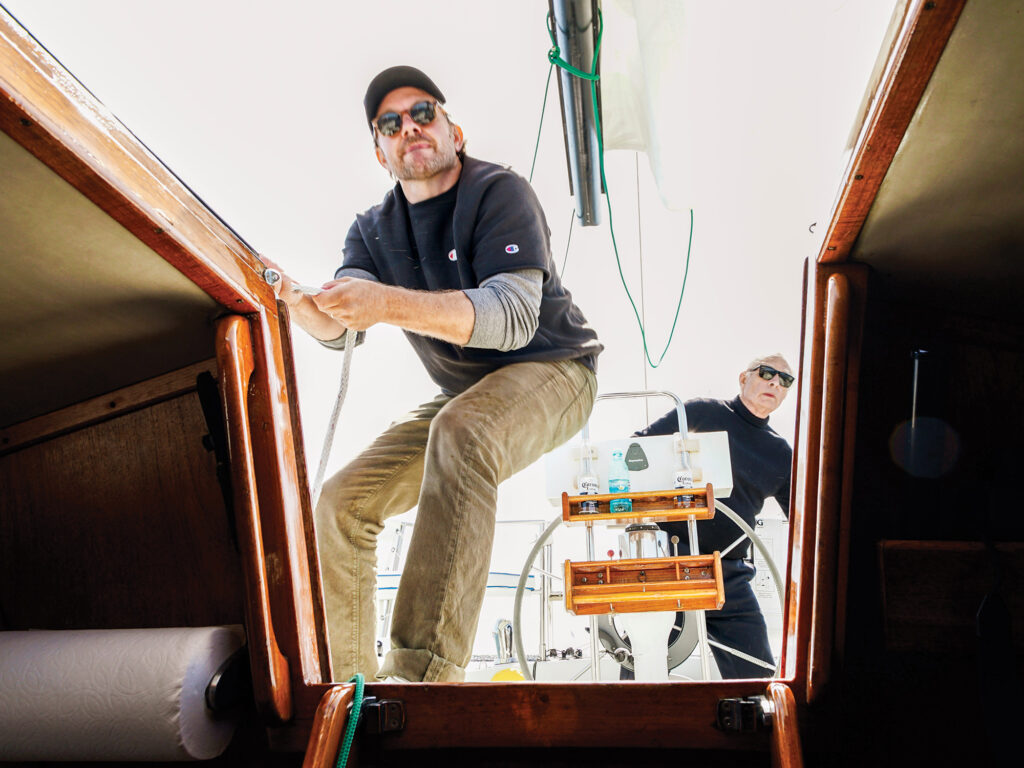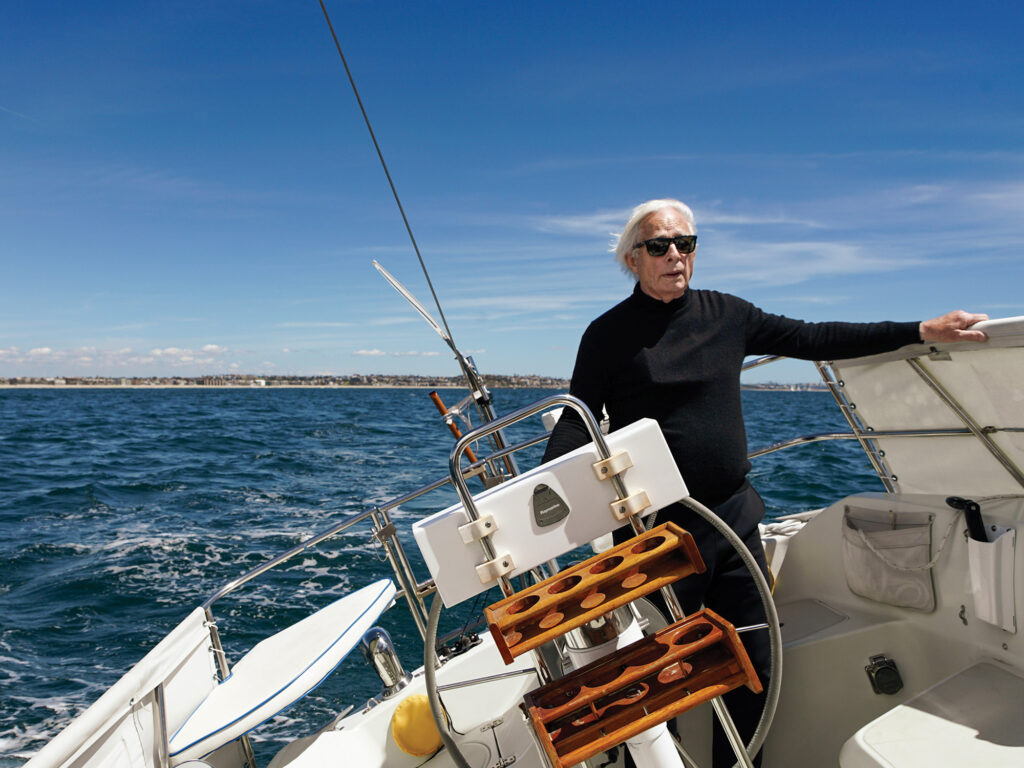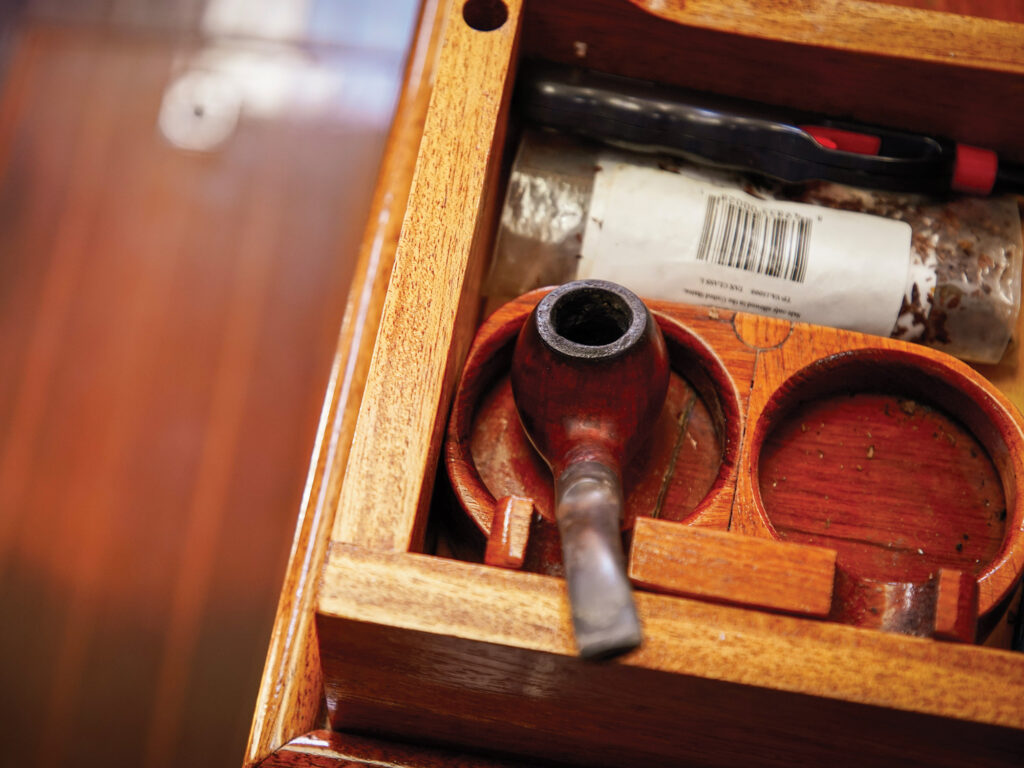
I was at home trying on outfits, preparing to meet author, yachtsman and YouTuber Christian Williams. My aim, I’d told my wife, was to look nautical, literary or, at the very least, not silly. “Do we own any turtlenecks?” I asked, searching through our closet.
Emily had left the room, and our 9-year-old son stood in her place. “A turtleneck?” Ezra asked, shaking his head. “Dad, who’s more famous? You or this guy you’re going sailing with?”
Christian Williams is a former newspaper editor and television producer. In the 1970s and 1980s, he was at The Washington Post. He worked on Bob Woodward’s legendary investigative team, and sailed with Ted Turner and won the 1979 Fastnet race. He completed three solo passages from Los Angeles to Hawaii (and back), most recently at age 78. He’s also the author of five books, and has written and produced multiple TV shows. “Oh, and he’s the creator of a YouTube sailing channel with 75,000 subscribers and over 10 million views,” I said.
“So, he’s way more famous than you,” Ezra said. I stepped toward the mirror wearing the same pants and sweatshirt that I wear five days a week as a stay-at-home dad, daytime sailor and part-time writer. “Well, we’re sort of in different lanes,” I explained.
When I pitched this story to my editor, I was all confidence: I’ll go sailing with Williams, interview him, and explore what a noob sailor like me can learn from a seasoned singlehander. But when the moment arrived to pick up the phone and call Williams, I bit my nails and rewatched some of his sailing videos. I put on the audio edition of his book Alone Together and tidied my apartment. Lunchtime passed. I’d rehearsed my lines and twice microwaved my coffee when my wife advised: “Just listen to some pump-up music and give him a call. You got this, David.”
I left Williams a voicemail. A couple of days later, I was driving through Los Angeles, listening to “Caribbean Queen” by Billy Ocean, when my phone rang. “Yes, I’ll help with the story as needed,” Williams said in his cool, New England accent.
“Well, it’ll be a fun, lighthearted piece,” I stammered, revealing my own jitters.
“Or it can be as serious as it needs to be,” he said.
I thanked Williams and told him what a big deal this was for me as a fan and newish sailor. “Among my friends, you’re sort of a household name,” I gushed.
“A household name?” Williams said with a chuckle. “Well, maybe only in my household.”
It’s a sunny Southern California Saturday afternoon when I arrive at Marina Del Rey to go sailing with Williams. I stand under a flagpole at California Yacht Club, holding a life vest and a six-pack of beer. In the distance, Williams, down on the dock, is preparing Thelonious II, his Ericson 38.

Since I began sailing two years ago, I’ve had to quit counting the number of people who’ve suggested that I watch Williams’ videos (I have), read his books (I am), or look for him on the water. I’m a bit star-struck when my 6-foot sailing hero appears, walks me down the dock, and welcomes me aboard his boat. “So this Ericson is a 1972?” I ask.
“It’s an ’84,” Williams says. “Come on inside.”
My gawd, I’ve set only one foot on the boat, and I’m already making unforced errors.
One measure of a sailor’s acumen is technical skills: navigating, trimming sails, reading wind and weather. Another measure, I soon realize, is the ability to welcome others aboard, weave them into the sailing experience, and keep them safe. Williams gives me a quick tour of his Ericson’s wood-trimmed cabin, offers pointers on how to move around the deck, shows me where handholds can be found, and tells me what would unfold in the unlikely event that one of us goes overboard.
I tell Williams that I’m not planning to fall off the boat today. In fact, I’m not really planning anything. My aim is simply to sail with one of my heroes, soak up the experience, and talk shop over drinks afterward.
Williams casts off the lines and expertly prop-walks his boat out of the slip. As he motors through the marina’s main channel, we pass port-to-port with a sailboat that’s dragging six fenders through the water. Williams shakes his head and makes some well-crafted jokes about California boaters. I laugh along. I hope that he doesn’t discover the 2020 magazine cover with a photo of me aboard my newly acquired Cape Dory 25, committing the same sin.
“Take the helm, would you?” he asks a few moments later. “And take us up to 5 knots.”
I have to make a lucky guess about which lever is the throttle. Then, standing at the helm, I watch as Williams goes forward, heaves on the main halyard, and raises a crisp, new mainsail.
Skies are blue. The wind is 10 knots. We’ve just cleared the harbor breakwall and entered the open water of Santa Monica Bay. “Feels a lot like steering a car,” I call out, raising my voice above the breeze as Williams makes his way back to the cockpit.
“Is that how you steer your car?” he asks, cracking a smile. “You wobble the wheel back and forth?”
I guess I haven’t mentioned that this is my first time with wheel steering, or that the sailing column I write is called “The Noob Files,” or that my most popular story is about crashing my boat into the dock.
“Well, how do you hold the wheel still?” I ask, seeking expert advice.
Williams tilts his head and considers the question. “You hold it still.”
We both laugh.
For the next few miles, we sail closehauled, heeled over at 15 or 20 degrees. Williams chats with me about the spoils of Santa Monica Bay (“summer sailing here never gets old”), a few of his favorite things about the Ericson (“its graceful hull form”), and some of the small leaks he chased down during his most recent passage from Hawaii to Los Angeles. After seven decades on the water, he’s calm, cool-headed and confident—approximately the opposite of myself. My first two years of singlehanded sailing have been an emotional roller coaster. At first I feared the wind, then the waves, then the immensity of the ocean. Above all, though, what I’ve feared most is screwing up. Maybe that’s why so many of my stories highlight my mistakes.
While I “steer,” Williams goes forward. He studies his furler drum, gazes up at his new genoa, and then sits on the bow pulpit for a while and looks out at sea. Is he bored? I wonder. Does sailing get dull after one has completed long solo adventures offshore?
Soon, I’ll ask him. For now, we’re a mile or so offshore in 10 knots of breeze, and the 74-foot Foggy is screaming past us. The boat—designed by Germán Frers with input from its owner, architect Frank Gehry, and built at Brooklin Boat Yard in Maine—is packed with surprises. It has more than 800 pieces of glass flush-mounted on the surface of its teak deck. In the salon, there are colorful carpets and a sheepskin sofa. But what’s really surprising is that, while sailing with a well-known author and yachtsman aboard what many sailors would consider a famous boat, we were both now stargazing.
We’ve gone 3 or 4 miles upwind when we reach the Santa Monica Pier. Williams tacks, oversteering a bit to make my genoa trimming easier, then points us back toward Marina Del Rey. With some luck and instruction, I adjust the traveler.
“Well, how do you hold the wheel still?” I ask, seeking expert advice. Williams tilts his head and considers the question. “You hold it still.”
Then, over a couple of beers, we swap stories about the joy of sailing small boats as kids. Williams says that his first boat was a red $20 kayak that his father purchased. Mine, I tell him, was an orange 12-foot Snark borrowed from a neighbor. Eventually, the Williams family would move up from Moths to Penguins to Lightning boats. Then, later, they’d spend New England summers on wooden cruisers exploring Long Island Sound.
“Much of it captured while passing an 8-millimeter movie camera around,” Williams says in one of his videos detailing a family cruise in 1961. “Each roll of film in the camera was 50 feet long and took three minutes of film.”
Six decades later, Williams is still happy to be on the water, and he’s still shooting movies. In videos, he sews cushions, stops leaks and disassembles pumps. He explores how to sail and why we sail, and he muses on philosophy, time, meaning, and memory.

On our homestretch, Williams holds the wheel and handles the lines. For a time, our small talk grows quiet. It’s just the sound of birds and the lap of water. And that’s when it hits me: Nothing crazy is going to happen today. We don’t have 30 knots on the nose. We’re not crossing oceans. No records are being set.
Maybe it’s all for the better. You see, what’s brought me here isn’t Williams’ achievements or know-how. What’s drawn me is his “knowing that,” his reflective, philosophical side, and the way that sailing seems to have shed light on, widened, and added depth to his life. That’s what I admire and want to explore and emulate.
There’s a harbor breakwall that protects Marina Del Rey’s main channel. After we steer behind it, the wind drops off, the water turns flat, and the Ericson’s genoa sways gently like a curtain. As we drift, one of the sheet lines backs out through a genoa block, escaping slowly before falling silently into the water.
In a moment, the line will be retrieved. We’ll start the motor, drop the sails, and return to the dock. But what’s the hurry? For now, Williams simply looks down, watching the line as it trails alongside us in the water, perhaps remembering something from a lifetime spent messing about on boats.
“Should I get that?” I eventually ask.
Williams smiles. “Sure,” he says, still gazing into the water. “Why not?”
David Blake Fischer is a “noob” sailor living in Southern California. He hasn’t crossed oceans. In fact, he’s only recently crossed the Santa Monica Bay. Follow him on Instagram as he fumbles out of the channel, backwinds his jib, and sometimes drags his fenders on Delilah, his Cape Dory 25.
Calamari and Cocktails
Inside California Yacht Club, the author sat down with Williams at a corner table overlooking the slips for a chat.
You’ve said that sailing is an open door to the universe, where life on the other side is forever changed. How has sailing changed you or transformed your life?
I think it’s fair to say that sailing has sustained me through everything. For some people, it might be love of dogs or something, but for me, through all the ups and downs, sailing was always there because it is that window to the universe.
As a kid, you spent summers sailing with your family on Long Island Sound. What did those early experiences teach you?
I was fully aware that my father had learned how to sail as an adult. He had come back from the war, probably around age 30, and didn’t know how to do it. It was all learned. Meanwhile, I was 12, and I took to it instinctively. And the overriding message to me was: This is something I can do well. And it sustained me through high school and beyond. Whenever I screwed up something, at least I was good at sailing.
You’ve raced, completed long passages offshore, chased thrills, and found adventure. Does daysailing on familiar waters get boring after all of that?
You only have to go 1 mile offshore, and you might as well be in the middle of the Pacific Ocean. Your senses pick up the wind and waves, and you find that you’re alone. And, really, on boats from Sailfish to multihull ocean races, as soon as I’m out of sight of land, I feel I’m in the right place to recognize myself. When I’m at a cocktail party, it’s a performance. But offshore, you remove the audience, and you’re just who you are. And that’s more interesting than terrifying. Because you find out you’re just a part of the whole. And believe me, in the city, I don’t feel that way. Life in the city is a constant performance, a competition. Always has been. But if you take anybody and put them alone at sea, they encounter a different universe.
In the 1960s and 1970s, a large number of Americans went sailing. Today, thanks in part to YouTube and the availability of older fiberglass boats, a new generation of people are finding their way onto the water. What wisdom would you offer those who are just getting started in sailing?
When you’re 80, which I am, these things appear to you as aphorisms. It sounds like a Nike slogan, but just do it. If you want to sail around the world, quit worrying about the right boat. Do it in the boat you have. Do it tomorrow. Often, we mistake prudence for wisdom. We spend much of our lives trying to perfect the beginning. I say, quit worrying about it. Do it. You might just learn something and get an accomplishment out of it.
Your videos skewer the notion that singlehanded sailors are fearless stoics, immune to discomfort, content in the silence of the universe. What are singlehanded sailors really like?
It would be easier at the age of 30. So there’s that. But seriously, and I don’t mean to get philosophical, but we judge ourselves too much. Everything is a judgment of self, a categorization of our behavior, seeing ourselves in the light of what others might think. But if you’re a singlehanded sailor, 1,000 miles offshore, nobody is judging you. And it’s a great feeling.
There’s a calm vibe to your videos of offshore passagemaking. Are you really that calm out there? Is there an overwhelmed, overreacting or fearful side of Christian Williams?
Be gentle with me, but I’ve never felt fear out there. On my tombstone, it’ll probably say, “How did he do?” So you put yourself on a sailboat, on an airplane, or speaking before a thousand people: It’s all a test of where you stand in your own universe. How did I do? For me, the fear is humiliation, and the reward is…I did OK. It’s been a beneficial, providential driving force in my life. How far can I push things without screwing them up? That’s good. That’s worth doing.
How does sharing an offshore passage via YouTube change the experience of solo sailing?
There’s a video gene that desires to document one’s time on Earth. When it comes to sailing, I don’t think anyone has accurately documented it. I’ve made every mistake in the book, and I want people to know what those mistakes are, laugh, and then proceed at a more accelerated pace than I did. But I want them to wind up in the same place, which is, just, the awe of it.
We’re all out there chasing or following after something. For some, it’s peace or tranquility. For others, it’s adventure. What have you been chasing?
For me, sailing has been about opening a door and seeing what’s on the other side. And, as you do, you sense that the door’s not easy to open, and you don’t know what’s on the other side. And you get only a glimpse of it.
You’ve solo-sailed from Los Angeles to Hawaii three times. Have you found what you were looking for?
You come back from a summer sailing to Hawaii and back alone. Your first thought is, I’m never doing that again. It’s really uncomfortable. Two months later, your thought is, I’ve got to do that again. There’s something out there I missed. I didn’t ask the right question of myself when I had the chance. I’ve got to go back. I’ve done this trip three times for that simple reason.
Will there be a fourth trip?
Maybe.








